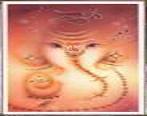The Dasharatha Jataka: Introduction
The Dasharatha Jataka is different in many ways from the Valmiki Ramayana. We must
remember too that there are a great many Ramayanas and many Ramayanas are considered lost (Hanuman's Ramayana being an example).
Of course we must also remember that this is a Jataka story or birth story, a wholly different genre of spiritual
literature only present in Buddhist teachings.
Even then, there is a big difference in the stories. Rama, Laxman and Sita are in
brothers and sister, born from the same mother and father. Dashratha is the King of Varanasi, one of the holiest seats
of Shiva and not Ayodhya. Bharata is the step brother born to another chief queen after the former chief queen
(mother of Rama, Lakkhan and Sita) dies.
Now in much of Sanskrit literature (as one can see from the above posted images), Rama
and Hanuman are both considered aspects of Shiva, and Varanasi is considered to be his kingdom. So from an Indian perspective
and spiritual perspective, it makes more sense for Dasharatha and later Rama to be Kings of Varanasi.
In the Valmiki Ramayana, Sita is an adopted daughter of King Janaka who finds her abandoned
in the earth. Valmiki's Ramayana literally becomes mysoginistic tale.. She get's married to Rama, accuses Laxman
of trying to get rid of Rama to marry her, doesn't follow directions and is kidnapped by Ravana and is accused of being impure
and is eventually abandoned by Rama in the forest while she is pregnant because of mere rumors of a launderer who questions
her purity. She eventually returns to the earth being fully abandoned by Rama.
A Genesis Story?
In the Buddhist Jataka, Sita is the daughter of none other than Dasharatha himself.
She goes to the Himalayas with both her brothers due to Dasharatha's fear of their step mother trying to kill his children
to install Bharata in a palace intrigue. She is kept perfectly safe, she is never kidnapped or accused of being impure
-- the only troublesome catch in the story -- she is eventually married to Rama.upon his return to the palace.
Before we make any commentaries on this story it is important to note that these are a
part of spiritual mythography, where a literal meaning is generally not given.
CLEAN YOUR FILTHY MIND! NO IT'S NOT WHAT YOU THINK!
We must always read the Jataka stories in context of Buddha's teachings. Rama, i.e.
the Bodhisata, states,"all comprehending wisdom like mine is not theirs."
-- all comprehending wisdom! So if you think there is something dirty in this story...to the laundry your mind goes.
Indeed, when we read the Aganna Sutta on the beginning of sexual
relationships due to degeneration, or the story of Kashyap, we also begin to understand the ideals of virtue, as taught in
Buddhism in marriage.
So Bhadda was taken to Magadha and the young couple were married. However, in accordance
with their ascetic yearning, both agreed to maintain a life of celibacy. To give expression to their resolve, they would lay
a garland of flowers between them before they went to bed, determined not to yield to sensual desire....
It is said that the earth, shaken by the power of their virtue, quaked and trembled.
And perhaps in the most beautiful passage of all, from the Mahayana Vimalkirti Nirdesh
Sutra we have the truest and final meaning of Rama, the divine Bodhisat marrying his "sister" Sita,
Of the true bodhisattvas,
The mother
is the transcendence of wisdom,
The father is the skill in liberative technique;
The Leaders are born of such parents.
Their wife is the joy in the Dharma,
Love and compassion are their
daughters,
The Dharma and the truth are their sons;
And their home is deep thought on the meaning of voidness.
So here, the marriage of Rama and Sita is the union of the joy of Dharma between Dharma and compassion!

